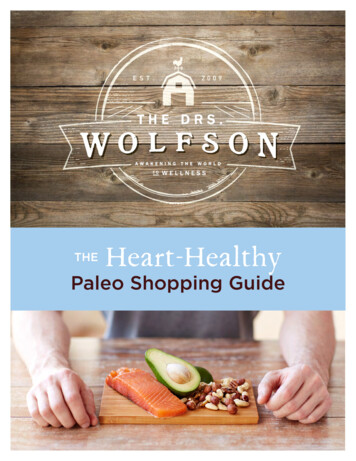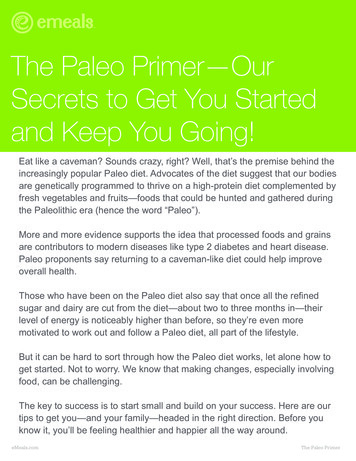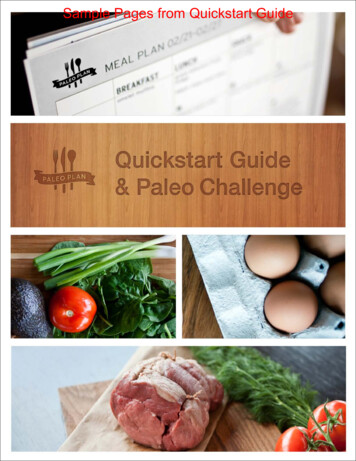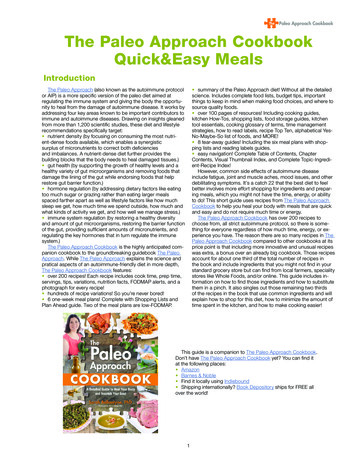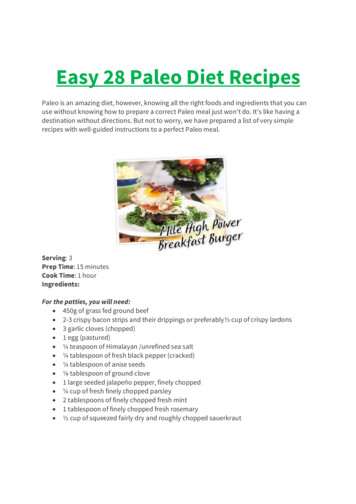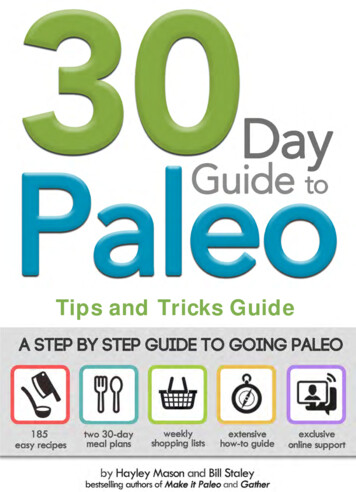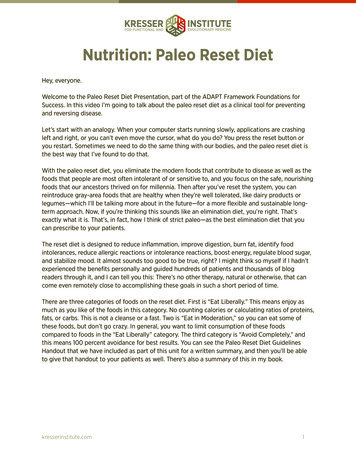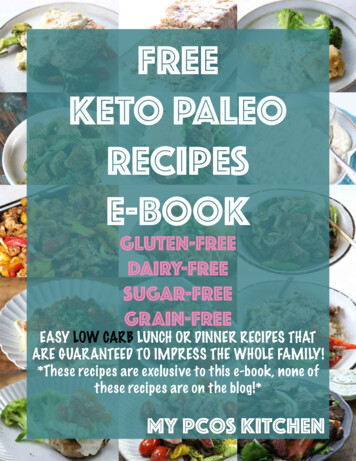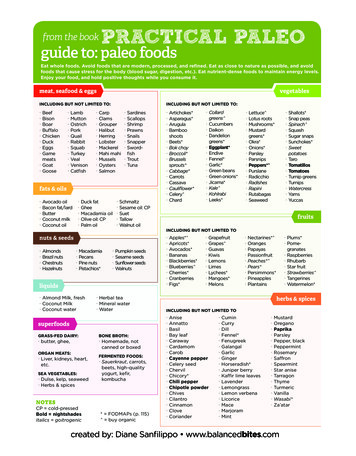
Transcription
from the bookPRACTICAL PALEOguide to: paleo foodsEat whole foods. Avoid foods that are modern, processed, and refined. Eat as close to nature as possible, and avoidfoods that cause stress for the body (blood sugar, digestion, etc.). Eat nutrient-dense foods to maintain energy levels.Enjoy your food, and hold positive thoughts while you consume it.meat, seafood & eggsvegetablesINCLUDING BUT NOT LIMITED TO:·· Beef·· Bison·· Boar·· Buffalo·· Chicken·· Duck·· Eggs·· Gamemeats·· Goat·· Goose·· Lamb·· Mutton·· Ostrich·· Pork·· Quail·· Rabbit·· Squab·· Turkey·· Veal·· Venison·· CatfishINCLUDING BUT NOT LIMITED TO:·· Carp·· Clams·· Grouper·· Halibut·· Herring·· Lobster·· Mackerel·· Mahi mahi·· Mussels·· Oysters·· Salmon·· Sardines·· Scallops·· Shrimp·· Prawns·· Snails·· Snapper·· Swordfish·· Trout·· Tunafats & oils·· Avocado oil·· Bacon fat/lard·· Butter·· Coconut milk·· Coconut oil·· Duck fat·· Ghee·· Macadamia oil·· Olive oil: CP·· Palm oil·· Schmaltz·· Sesame oil: CP·· Suet·· Tallow·· Walnut oilnuts & seeds·· Almonds·· Brazil nuts·· Chestnuts·· Hazelnuts·· Macadamia·· Pecans·· Pine nuts·· Pistachios*·· Pumpkin seeds·· Sesame seeds·· Sunflower seeds·· Walnutsliquids··Almond Milk, fresh··Coconut Milk··Coconut water··Herbal tea··Mineral water··WatersuperfoodsGRASS-FED DAIRY:··butter, ghee,ORGAN MEATS:··Liver, kidneys, heart,etc.SEA VEGETABLES:··Dulse, kelp, seaweed··Herbs & spicesBONE BROTH:··Homemade, notcanned or boxedFERMENTED FOODS:··Sauerkraut, carrots,beets, high-qualityyogurt, kefir,kombuchaNOTESCP cold-pressedBold nightshadesItalics goitrogenic* FODMAPs (p. 115) buy organic·· Artichokes*·· Asparagus*·· Arugula·· Bambooshoots·· Beets*·· Bok choy·· Broccoli*·· Brusselssprouts*·· Cabbage*·· Carrots·· Cassava·· Cauliflower*·· Celery ·· Chard·· Collardgreens ·· Cucumbers·· Daikon·· Dandeliongreens*·· Eggplant*·· Endive·· Fennel*·· Garlic*·· Green beans·· Green onions*·· Jicama*·· Kale ·· Kohlrabi·· Leeks*·· Lettuce ·· Lotus roots·· Mushrooms*·· Mustardgreens*·· Okra*·· Onions*·· Parsley·· Parsnips·· Peppers* ·· Purslane·· Radicchio·· Radishes·· Rapini·· Rutabagas·· Seaweed·· Shallots*·· Snap peas·· Spinach ·· Squash·· Sugar snaps·· Sunchokes*·· Sweetpotatoes·· Taro·· Tomatillos·· Tomatoes·· Turnip greens·· Turnips·· Watercress·· Yams·· YuccasfruitsINCLUDING BUT NOT LIMITED TO·· Apples* ·· Apricots*·· Avocados*·· Bananas·· Blackberries*·· Blueberries ·· Cherries*·· Cranberries·· Figs*·· Grapefruit·· Grapes ·· Guavas·· Kiwis·· Lemons·· Limes·· Lychees*·· Mangoes*·· Melons·· Nectarines* ·· Oranges·· Papayas·· Passionfruit·· Peaches* ·· Pears*·· Persimmons*·· Pineapples·· Plantains·· Plums*·· Pomegranates·· Raspberries·· Rhubarb·· Star fruit·· Strawberries ·· Tangerines·· Watermelon*herbs & spicesINCLUDING BUT NOT LIMITED TO··Anise··Annatto··Basil··Bay leaf··Caraway··Cardamom··Carob··Cayenne pepper··Celery seed··Chervil··Chicory*··Chili pepper··Chipotle rseradish*··Juniper berry··Kaffir lime leaves··Lavender··Lemongrass··Lemon r, rmint··Star �·Wasabi*··Za’atarcreated by: Diane Sanfilippo www.balancedbites.com
from the bookPRACTICAL PALEOguide to: stocking a paleo pantryFresh is best. Shopping the perimeter of the grocery store is ideal for the bulk of your foods, but you will wantto add spices and some pantry items to your arsenal to cook up some tasty dishes and have some stand-byfoods on-hand. Some of these foods are sold in cold sections of the store and need to be kept cold despitebeing packaged items.herbs & spicesfats & oilsSOME HERBS CAN BE FOUND IN BOTH FRESH AND DRIED FORMS.INCLUDING BUT NOT LIMITED TOSEE THE FATS & OILSGUIDE FOR DETAILS··Anise··Annatto··Basil··Bay leaf··Caraway··Cardamom··Cayenne··Celery seed··Chervil··Chicory*··Chili inger··Horseradish··Juniper berry··Kaffir lime leaves··Lavender··Lemongrass··Lemon �Mustard··Nutmeg··Onion , black··Peppercorns,whole black··Peppermint··Pumpkin pie spice··Rosemary··Saffron··Sage··Sea salt··Spearmint··Star �·Wasabi··Za’atarcanned & jarredINCLUDING BUT NOT LIMITED TO··Anchovy paste··Applesauce*··Capers··Coconut milk*··Coconut water/Juice*··Fish roe··Herring - �Salmon - wild··Sardines - wild··Sun-driedtomatoes··Sweet potato··Tahini··Tomato paste··Tomato sauce··Tuna - wild··Coconut*:shredded, flakes··Dates··Dried apples*··Dried �·Dried currants··Dried figs*··Dried mango*··Dried damia nuts··Pecanssauces··Coconut aminos *(soy-replacement)··Fish sauce(Red Boat brand)··Hot sauce (gluten-free)··Mustard (gluten-free)··Vinegars: apple cider*,red wine, distilled,rice and balsamic(avoid malt vinegar)beveragesnuts, seeds & dried fruit··Almonds··Almond butter··Almond flour··Bananachips (checkingredients)··Brazil nuts··Chestnuts··Coconut butter*··Avocado oil: CP··Bacon fat··Ghee··Coconut oil··Macadamia oil: CP··Extra-virgin olive oil··Palm oil··Palm shortening··Sesame oil: CP··Walnut oil: CP··Pine nuts··Pistachios*··Pumpkin seeds··Sesame seeds··Sunflower seeds··Walnutsadd your own!MAYBE YOU HAVE FAVORITE ITEMS NOT LISTED ABOVE THAT YOU KNOW ARE PALEOFRIENDLY; WRITE THEM IN TO USE THIS AS A SHOPPING LIST··Green tea··Herbal tea··Mineral water··White tea··Organic coffeetreats & sweetsFOR OCCASIONAL USE··Carob powder··Cocoa powder··Honey··Maple syrup··Molasses··Dark chocolateNOTESCP cold-pressedbold nightshadesitalics goitrogenic* FODMAPs (p.115)Buy as many of yourpantry items as possiblein organic form.created by: Diane Sanfilippo www.balancedbites.com
from the bookPRACTICAL PALEOguide to: food qualitySeek out as much real, whole food as possible. This includes foods without health claims on the packages or, betteryet, not in packages at all. Think produce and butcher counter meats and seafood. After you’ve mastered makingproper food choices, it’s important to begin looking at the quality of the items. While buying the best quality isideal in a perfect world, don’t let those “best” labels keep you from doing the best you can within your means.meat, eggs & dairybeef & lambBest! 100% grass-fed and finished,pasture-raised, localBetter: grass-fed,pasture-raisedGood: organicBaseline: commercial(hormone/antibiotic-free)porkBest! pasture-raised, localBetter: free-range, organicGood: organicBaseline: commercialseafoodeggs & poultryBest! pasture-raised, localBetter: free range, organicGood: cage-free, organicBaseline: commercialdairyALWAYS BUY FULL-FATBest! grass-fed, raw/unpasteurizedBetter: raw/unpasteurizedGood: grass-fedBaseline: commercial or organic—not recommendedWHAT THE LABELS ON MEAT, EGGS & DAIRY MEANpasture-raisedAnimals can roam freely in theirnatural environment where theyare able to eat nutritious grassesand other plants or bugs/grubsthat are part of their natural diet.There is no specific pasture-raisedcertification, though certifiedorganic meat must come fromanimals that have continuousaccess to pasture regardless ofuse.cage-free“Cage-Free” means uncagedinside barns or warehouses, butthey generally do not have accessto the outdoors. Beak cutting ispermitted. There is no third partyauditing.organicAnimals may not receivehormones/antibiotics unless inthe case of illness. They consumeorganic feed and have outdooraccess but may not use it. Animalsare not necessarily grass-fed.Certification is costly and somereputable farms are forced toforego it. Compliance is verifiedthrough third party auditing.naturalfree-range/roamingPoultry must have access to theoutdoors at least 51% of the time,and ruminants may not be infeedlots. There are no restrictionsregarding what the birds canbe fed. Beak cutting and forcedmolting through starvation arepermitted. There is no third partyauditing.naturally raised“Naturally Raised,” is a USDAverified term. It generally meansraised without growth-promotersor unnecessary antibiotics. It doesnot indicate welfare or diet.no added hormonesIt is illegal to use hormones inraising poultry or pork; therefore,the use of this phrase on poultryor pork is a marketing ploy.vegetarian-fed“Vegetarian Fed” implies thatthe animal feed is free of animalby-products but isn’t federallyinspected. Chickens are notvegetarians, so this label on chickenor eggs only serves to indicate thatthe chickens were not eating theirnatural diet.“Natural” means “minimallyprocessed,” and companies usethis word deceivingly. All cutsare, by definition, minimallyprocessed and free of flavoringsand chemicals.Best! wild fishBetter: wild-caughtGood: humanely harvested, non-grain-fedBaseline: farm-raised—not recommendedWILD FISH/ WILD-CAUGHT FISH“Wild fish” indicates that the fish wasspawned, lived in, and was caught in thewild. “Wild-caught fish” may have beenspawned or lived some part of their lives ina fish farm before being returned to the wildand eventually caught. The Monterey BayAquarium maintains a free list of the mostsustainable seafood choices on their website.produceBest! local, organic, and seasonalBetter: local and organicGood: organic or localBaseline: conventionalWHEN TO BUY ORGANIC:Buy organic as often as possible,prioritize buying the EnvironmentalWorking Group’s “The Dirty Dozen” asorganic versus “The Clean Thirteen” visit: www.ewg.org for detailsPRODUCE SKUs:Starts with 9 organic - idealStarts with 3 or 4 conventionally grownStarts with 8 genetically modified(GMO) or irradiated - avoidfats & oilsSEE THE FATS & OILS GUIDE FOR DETAILS.Best! organic, cold-pressed, and fromwell-raised animal sourcesBetter: organic, cold-pressedGood: organic or conventionalnuts & seedsKEEP NUTS & SEEDS COLD FOR FRESHNESSBest! local, organic, kept coldBetter: local, organicGood: organicBaseline: conventionalsources: www.humanesociety.org, www.ewg.org, www.sustainabletable.orgcreated by: Diane Sanfilippo www.balancedbites.com
from the bookPRACTICAL PALEOguide to: fats & oilsCleaning up your diet by using the right fats and oils is essential to improving your health from the inside out.Changing the fats and oils you use at home is the first step toward creating dishes from nutrient-dense, wholefoods based on what you have on hand. Avoid overly processed and refined forms of fats and oils. Opt fororganic whenever possible. Refer to the “Guide to Cooking Fats” for more details.eat these: HEALTHY, NATURALLY OCCURRING, MINIMALLY PROCESSED FATSsaturated: FOR HOT USESBUY ORGANIC, UNREFINED FORMS··Coconut oil··Palm oilIDEALLY FROM PASTURE-RAISED,GRASS-FED, ORGANIC SOURCES··Butter··Ghee, clarified butter··Lard, bacon grease (pork fat)··Tallow (beef fat)··Duck fat··Schmaltz (chicken fat)··Lamb fat··Full-fat dairy··Eggs, meat, and seafoodunsaturated:FOR COLD USESBUY ORGANIC, EXTRA-VIRGIN, ANDCOLD-PRESSED FORMS··Olive oil··Sesame oil··Macadamia nut oil··Walnut oil··Avocado oil··Nuts & seeds (including nut & seed butters)··Flaxseed oil**NOTE: Unsaturated fats (typically liquid at68 degrees room temperature) are easilydamaged/oxidized when heat is applied tothem. Do not consume damaged fats.**Cold-pressed flaxseed oil is okay foroccasional use but supplementing withit or doses of 1-2 tablespoons per dayis not recommended as overall PUFA(polyunsaturated fatty acid) intake shouldremain minimal.ditch these: UNHEALTHY, MAN-MADE FATS & REFINED SEED OILS ARE NOT RECOMMENDEDHydrogenated or partially hydrogenated oils,as well as manmade trans-fats or “butteryspreads” like Earth Balance, Benecol, and ICan’t Believe It’s Not Butter are not healthy.These oils are highly processed and oxidizeeasily via one or more of the following: light,air, or heat.··Margarine/buttery spreads··Canola oil (also known as rapeseed oil)··Corn oil··Vegetable oil··Soybean oil··Grapeseed oil··Sunflower oil··Safflower oil··Rice bran oil··Shortening made from one or moreof the above-listed “ditch” oilscreated by: Diane Sanfilippo www.balancedbites.com
from the bookPRACTICAL PALEOguide to: cooking fatsChoose fats and oils based on: 1. How they’re made—choose naturally occurring, minimally processed optionsfirst; 2. Their fatty acid composition—the more saturated they are, the more stable/less likely to bedamaged or oxidized; 3. Smoke point—this tells you how hot is too hot before you will damage thefats, though it should be considered a secondary factor to fatty acid profile.culinary whizzes, listen up:ITEM NAME% SFACOOK WITH GOOD FATS!%MUFA% PUFAbest bets - recommended for high-heat cookingSMOKE POINTUNREFINED/REFINEDTHE MOST STABLE FATSCoconut oil8662350/450Butter/ghee6326.03300/480Cocoa butter60355370Tallow/suet (beef fat)5534.03400Palm oil5442.10455Lard/bacon fat (pork fat)394511375Duck fat375013375okay - for very low-heat cookingMODERATELY STABLE FATSAvocado oil*207010520Macadamia nut oil*16804410Olive oil*147311375Peanut oil**174632320/450Rice Bran Oil**253837415not recommended for cookingVERY UNSTABLE FATSSafflower oil**87613225/510Sesame seed oil*144046450Canola oil**86428400Sunflower oil**104540225/440Vegetable shortening**341152330Corn oil153055445Soybean oil162358495Walnut oil*141967400Grapeseed oil121771420SFA - saturated fatty acidMUFA - monounsaturated fatty acid* While not recommended for cooking, cold-pressed nutand seed oils that are stored in the refrigerator may beused to finish recipes or after cooking is completed—forflavor purposes.PUFA - polyunsaturated fatty acid** While the fatty acid profile of these oils may seemappropriate at first glance, the processing method bywhich they are made negates their healthfulness—theyare not recommended for consumption, neither hot norcold.created by: Diane Sanfilippo www.balancedbites.com
from the bookPRACTICAL PALEOguide to: sweetenersHow many of these sweeteners do you use or find in your favorite packaged foods? Perhaps it’s time fora change! Artificial sweeteners are never recommended, while the limited use of selected, more naturallyderived options can be okay for treats and special occasions. Sweeteners should not be considered“food” or nourishment.naturalUSE SPARINGLYPREFERRED CHOICES ARE IN BOLD. USE ORGANIC FORMS WHENEVER POSSIBLE··Brown sugar··Dates (whole)··Date sugar··Date syrup··Cane sugar··Raw sugar··Turbinadonatural··Cane juice··Cane juice crystals··Coconut nectar··Coconut sugar/crystals··Fruit juice (real, fresh)··Fruit juice concentrate··Honey (raw)··Maple syrup (grade b)··Molasses··Palm sugar··Stevia (green leaf or extract)artificialBUT NOT RECOMMENDED··Agave··Agave nectar··Barley malt··Beet sugar··Brown rice syrup··Buttered syrup··Caramel··Carob syrup··Corn syrup··Corn syrup solids··Demerara sugar··Dextran··Dextrose··Diastatic malt··Diastase··Ethyl maltol··Fructose··Glucose / glucose solids··Golden sugar··Golden syrup··Grape sugar··High fructose corn syrup··Invert sugar··Lactose··Levulose··Light brown sugar··Maltitol··Malt scovado··Refiner's syrup··Sorbitol··Sorghum syrup··Sucrose··Treacle··Yellow sugar··Xylitol (or other sugaralcohols, typically theyend in “-ose”)NEVER CONSUME··Acesulfame K(Sweet One)··Aspartame(Equal, Nutra-Sweet)··Saccharin (Sweet’N Low)··Stevia: white/bleached(Truvia, Sun Crystals)··Sucralose (Splenda)··Tagatosesugar is sugar BUT NOT REALLYIT DOES MAKE A DIFFERENCE WHICH SWEETENERS YOU SELECT, CONTRARY TO POPULAR BELIEF AND THE MAINSTREAMMEDIA. WHILE ALL CALORIC SWEETENERS HAVE THE SAME NUMBER OF CALORIES (16 PER TEASPOON), EVALUATING THEIRPLACE IN YOUR DIET MAY BE DONE BY CONSIDERING A FEW FACTORS.HOW IT’S MADEHOW YOUR BODY PROCESSES ITThe more highly refined a sweetener is, the worse it is foryour body. For example, high fructose corn syrup (HFCS)and artificial sweeteners are all very modern, factorymade products. Honey, maple syrup, green leaf stevia(dried leaves made into powder), and molasses are allmuch less processed and have been made for hundredsof years. In the case of honey, almost no processing isnecessary. As a result, I vote for raw, organic, local honeyas the ideal natural sweetener.Here’s where the HFCS commercials really get thingswrong: your body actually does not metabolize all sugarthe same way.WHERE IT’S USEDThis is a reality check. When you read the ingredientsin packaged, processed foods, it becomes obvious howmost of them use highly-refined, low-quality sweeteners.Food manufacturers often even hide sugar in foods thatyou didn’t think were sweets! Many foods that have beenmade low or non-fat have added sweeteners or artificialsweeteners—avoid these products!Interestingly enough, sweeteners like HFCS and agavenectar were viewed as better options for diabetics forquite some time since the high fructose content of bothrequires processing by the liver before the sugar hits yourblood stream. This yielded a seemingly favorable resulton blood sugar levels after consuming said sweeteners.However, it’s now understood that isolated fructosemetabolism is a complicated issue and that taxing theliver excessively with such sweeteners can be quiteharmful to our health.Fructose is the primary sugar in all fruit. When eatingwhole fruit, the micronutrients and fiber content of thefruit actually support proper metabolism and assimilationof the fruit sugar. Whole foods for the win!created by: Diane Sanfilippo www.balancedbites.com
from the bookPRACTICAL PALEOguide to: dense sources of paleo carbsRemoving grains, legumes, and refined foods from your diet doesn’t mean that carbohydrates needto all disappear! Check out this list of dense sources of carbohydrates while eating a Paleo diet.While fruits and nuts are all fairly high in carbohydrates, this list is a guide to starchy vegetables toeat. Remember, these are some of your "good carbs!"there are carbs beyond breadEAT UPITEMNAMECARBSPER 100GFIBERPER 100GCARBSPER 1 CUPOTHER NOTABLENUTRIENTSCassava (raw)38g2g78gVit C, Thiamin, Folate, Potassium, ManganeseTaro root35g5g46g, slicedB6, Vitamin E, Potassium, ManganesePlantain31g2g62g, mashedYam27g4g37g, cubedVit C, Vitamin B6, Manganese, PotassiumWhite potato22g1g27g, peeledTrace Vitamin CSweet potato21g3g58g, mashedVit A (beta carotene), Vit C, B6, Potassium,Manganese, Magnesium, Iron, Vitamin EParsnips17g4g27g, slicedVitamin C, ManganeseLotus root16g3g19g, slicedVitamin C, B6, Potassium, Copper,ManganeseWinter squash15g4g30g, cubedVitamin C, Thiamin, B6Onion10g1g21g, choppedVitamin C, PotassiumBeets10g2g17g, slicedFolate, ManganeseCarrots10g3g13g, choppedVitamin A (beta carotene), Vitamin K1Butternut squash10g-22gVitamin A (beta carotene), Vitamin CRutabaga9g2g21g, mashedVitamin C, Potassium, Manganese,Jicama (raw)9g5g12g, slicedVitamin CKohlrabi7g1g11g, slicedVit C, B6, Potassium, Copper, ManganeseSpaghetti squash6g1g9gTraceTurnips5g2g12g, mashedVitamin C, Potassium, Calcium, B6, Folate,ManganesePumpkin5g1g12g, mashedVitamin C, Vitamin E, PotassiumVitamin A (beta carotene), Vitamin C, B6,Magnesium, Potassiumsource: nutritiondata.comcreated by: Diane Sanfilippo www.balancedbites.com
from the bookPRACTICAL PALEOguide to: glutenWhat is it? Gluten is a protein found in wheat, rye oats, and barley. Gluten is the composite of a prolaminand a glutelin, which exist, conjoined with starch, in the endosperm of various grass-related grains. Gliadin,a water-soluble, and glutenin, a water-insoluble, (the prolamin and glutelin from wheat) compose about80% of the protein contained in wheat seed. Being insoluble in water, they can be purified by washingaway the associated starch. Worldwide, gluten is a source of protein, both in foods prepared directlyfrom sources containing it, and as an additive to foods otherwise low in protein.sources of gluten or items that may contain hidden gluten·· Ales·· Barley·· Barley malt/extract·· Beer & lagers·· Bran·· Breading·· Broth·· Brown rice syrup·· Bulgur·· Candy arro··Gloss & balms··Graham flour··Herbal blends·· Imitation·· Imitation seafood·· Kamut·· Lipstick·· Luncheon meats·· Malt·· Makeup·· Marinades·· Matzo flour/meal·· Meat/sausages·· Medications·· Orzo··Panko··Pasta··Play astingpoultry··Semolina··Soup base··Soy sauce··Spelt··Spice ·Triticale··Udon·· Vinegar (malt only)··Vital t bran··Wheat germ··Wheat starchgluten-free* (but still not recommended)signs of gluten exposure*Nearly all processed foods and grains carry some risk of crosscontamination. For the safest approach to a gluten-free diet, eatonly whole, unprocessed foods.·· Abdominal bloating·· Fatigue·· Skin problems or rashes·· Diarrhea or constipation·· Irritable, moody·· Change in energy levels·· Consult with your·· Unexpected weightnutritionist or physicianloss, mouth ulcers,if you experiencedepression, and evensymptoms of a glutenCrohn’s disease areexposure thatall more severe glutenresult in prolongedallergy symptoms thatdiscomfort.you may �·Corn··Flax··Millet··Montina ··Nut flour··Bean flour··Potato flour·· Potato starch··Quinoa··Rice··Rice bran··Sago··Seed flour··Sorghum··Soy (soya)··Tapioca··Teffmost common sources of hidden glutenAlcohol:Beer, malt beverages,grain alcoholsCosmetics:Check ingredients onmakeup, shampoo,and other personalcare itemsDressings:Thickened with flouror other additivesFried foods:Cross contaminationwith breaded items infryersMedications, vitamins,and supplements:ask the pharmacistand read the labelscloselyProcessed /packaged foods:Additives oftencontain glutenSauces, soups, andstews: Thickened withflourSoy, Teriyaki, andHoisin sauces:Fermented with wheatVinegar: Malt varietiesi am allergic to glutengluten-free a·· Vermouth·· Vodka·· Whiskey·· Wine·· Champagne·· Mead·· Hard cider·· Gluten-freebeersfor more information on glutenThese sites are not necessarily "Paleo" but will give ampleinformation for those who need to be 100% strictly freegirl.com··surefoodsliving.com“**According to celiac.com, all distilled alcohols are gluten-free but for someone with overt Celiac Disease, avoiding alcoholsmade from wheat, barley, and rye is still recommended.I have a severe allergy and have tofollow a STRICT gluten-free diet.I may become very ill if I eatfood containing flours or grainsof wheat, rye, barley, or oats.Does this food contain flour orgrains of wheat, barley rye, oroats? If you or the chef/kitchenstaff are uncertain about whatthe food contains, please tell me.I CAN eat food containing rice,maize, potatoes, vegetables,fruit, eggs, cheese, milk,meat, and fish as long as theyare NOT cooked with wheatflour, batter, breadcrumbs, orsauce containing any of thoseingredients.Thank you for your help!For more gluten-guides, visit:www.celiactravel.com Cut me out and take me with youcreated by: Diane Sanfilippo www.balancedbites.com
Adrenal Health Meal Plan Shopping ListndPractical Paleo 2 Edition pg. 162WEEK 1Veggies1 large zucchini10-12 large carrots (2 for sauerkraut)6 pounds sweet potatoWinter squash3 onions2 bell peppers2 baking potatoes3 green salads (per person)2 avocadosTomato1 jalapeño pepper2 spinach (served as sides)2 cauliflower headsCabbage (for sauerkraut)3 cucumbers2 green onions (scallions)1 red onion1 head of broccoliHandful of string beans1 head of romaine lettuce1 pint cherry tomatoes2-3 pounds new potatoes1 bunch of asparagus2 bunches of kale2 cups basil or cilantroMeats3 dozen eggs½ pound bacon12 bone-in, skin-on chicken thighs2 pounds flank steak2 cans salmon1 ½ pounds ground bison1 pound ground lamb1 pounds white fish (sole)Smoked salmon (lox) (2 ounces per roll)2 pounds skirt steak1 pound ground meat of choice2 pounds lamb stew meatWhole chickenFruits1 lime6 lemonsRaisins/currants2 bananas1 serving berries (per person)1 orangePlantainsPantryNutritional yeastNori sheetsMacadamia nutsAlmond butterWater chestnutsSesame seedsCanned pumpkinOlivesWEEK 2VeggiesParsnips (served as sides)13 large carrots (2 for sauerkraut)4 small russet potatoes3 bunches romaine hearts2 heads butter or bibb lettuce1 bell pepper1 cucumber1 red cabbage2 sweet potatoes (per person)Cabbage (for sauerkraut)1 large zucchini1 large onion8 portabella mushroom “buns”Lettuce and tomato for burgers1 head of broccoli1 small yellow onion1 pound frozen spinach1 14 ounce can artichoke hearts12 ounces baby spinach3 baking potatoes (per person)3 avocados3 scallions2 cauliflower head2 cups kale2 large Yukon gold potatoes3 green salads (per person)Pepperoncini1 pint cherry tomato1 pound asparagus2-3 large daikon radishes (app. 3 pounds)
Adrenal Health Meal Plan Shopping ListndPractical Paleo 2 Edition pg. 162Meats3 dozen eggs2 boneless, skinless chicken breasthalves½ pound bacon1 pound ground turkey1 ½ pounds ground meat1 pound boneless, skinless chickenbreast4 ounces prosciutto2 pounds boneless pork tenderloin1 pound ground pork2-3 pounds bone in short ribs2 ounces pancetta3 pounds bone-in, skin-on chickenthighs1 pound salmon1 pound boneless, skinless chickenthighs1 pound tuna steaksFruitsRaisins5 servings berries (per person)2 apples (per person)Lime3 bananas (per person)Pineapple8 dates5 lemonsPantryCapers15 ounce can tomato sauceWEEK 3Fruits3 apples (per person)Frozen peachesFrozen blueberries½ cup blueberries2 servings berries (per person)Banana16 ounces cranberries2 orange10 lemonsCurrantsMangoVeggies3 bunches of spinach (sides)2 bunches of spinach or kale (sides)7 avocados2 bell peppers2 green salads (per person)2 baking potatoes (per person)2 onions8 ounces diced tomatoes, canned or freshFresh basil2 sweet potatoesCabbage (sauerkraut)Spaghetti squash4 carrots (2 for sauerkraut)1 bunch celery2 bunches kale3 heads of cauliflower2 pounds red or gold potatoes2 heads butter lettuce2 large romanesco8 large gold or russet potatoes2 yellow onions2 small red onionsGrape tomatoesCherry tomatoes3 cucumbers4 cups arugula4 cups romaineFresh dillMeats3 dozen eggs2 pounds ground meat3 ½ pounds ground pork32 slices bacon1 pound boneless, skinless chicken thighs½ pound ground veal or beef2 pounds sea scallops2 pounds chicken legs2 pounds salmon fillet2 pounds boneless, skinless chickenbreastPantryOlivesAlmond butter3 ounces canned tomato pasteCollagen PeptidesChestnuts
Adrenal Health Meal Plan Shopping ListndPractical Paleo 2 Edition pg. 162WEEK 4 2 DAYSVeggies3 red onions3 yellow onions2 onions4 red bell peppers4 heads of cauliflower3 scallions5 pounds sweet potatoes2 butternut squashFresh sage2 heads of butter lettuce1 pint cherry tomatoesCilantro2 avocados5 shallotsTomatoes3 cucumbers8 cups romaineCelery bunch4 carrots (2 for sauerkraut)3 green salads (per person)Bunch of spinach (as a side)Cabbage (for sauerkraut)Bok choy (as a side)Acorn squashFresh sage4 small russet potatoes8 cups arugula or other dark leafy mix3 cups artichoke hearts1 cup sundried tomatoes12 baby portabella mushrooms6 cups spinach1 head broccoliRed cabbageFresh basilFresh cilantroFresh mintFresh dillMeats½ pound bacon2 sausage links or ¼ pounds ground pork3 dozen eggs2 large beef shanks (2 pounds)2 pounds skirt steak2 ½ pounds ground beef4 ½ pounds ground pork½ pound chicken livers2 6 ounce cans salmon1 pound sea scallops2 boneless, skinless chicken breast1 pound Italian sausage or ground pork1 pound ground chicken or turkey2 pounds bone-in, skin-on chicken3 pounds ground meatFruits3 apples (per person)1 apple3 green apples4 oranges6 servings berries (per person)1 banana (per person)4 bananas5 limesPineapple4 lemonsFresh cranberries2 green plantains1 pint blueberriesCurrants
Athletic Performance Meal Plan Shopping ListndPractical Paleo 2 Edition pg. 168WEEK 1Veggies1 large zucchini10-12 large carrots (2 for sauerkraut)2 sweet potatoes (per person)2 cups sweet potatoes2 pounds sweet potatoes2 sweet potatoes4 green salads (per person)4 onions2 bell peppersCilantro2 baking potato (per person)3 avocadosTomato1 jalapeño pepper2 spinach (as a side)2 heads of cauliflower20 grape leaves (16 ounce jar)2 cups basil or cilantroCabbage (for sauerkraut)3 cucumbersRed onion1 head broccoliHandful of string beansGreen onion/scallionsWinter squash of choiceHead of romaine lettuce1 pint cherry tomatoesFresh dill2-3 pounds new potatoes1 bunch asparagus2 bunches kaleMeats3 dozen eggs12 bone-in, skin-on chicken thighs2 servings bacon (per person)4 slices bacon2 pounds flank steak2 6-ounce cans salmon1 ½ pounds ground bison1 pound ground lamb1 pound sole or white fishSmoked salmon (lox) (2 ounces per roll)2 pounds skirt steak1 pound ground meat2 pounds lamb stew meatWhole chickenFruits6 lemons2 bananas (per person)Raisins or currants1 lime1 berries (serving per person)2 orangesPlantainsPantryOlives¼ cup macadamia nutsAlmond butterWater chestnutsSesame seedsCanned pumpkinNori sheetsWEEK 2Veggies15 large carrots (2 for sauerkraut)4 small russet potatoes3 bunches romaine hearts2 heads of butter or bibb lettuceBell pepperCucumberRed cabbageParsnips (as a side)2 sweet potatoes (per person)3 baking potatoes (per person)Cabbage (for sauerkraut)1 large zucchini1 large onion8 portabella bunsLettuce and tomato (for burgers)Broccoli (as a side)12 ounces baby spinach1 small onion1 pound frozen spinach1 14-ounce can artichoke hearts2 cups basil or cilantro4 avocados3 bunches green onions (scallions)2 head of cauliflower2 cups kale2 large Yukon gold potatoes3 green salads (per person)Pepperoncini1 pound
guide to: paleo foods Eat whole foods. Avoid foods that are modern, processed, and refined. Eat as close to nature as possible, and avoid foods that cause stress for the body (blood sugar, digestion, etc.). Eat nutrient-dense foods to maintain energy levels. Enjoy yo
